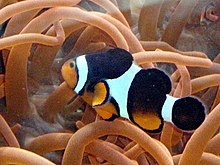Real clown fish
| Real clown fish | ||||||||||||
|---|---|---|---|---|---|---|---|---|---|---|---|---|

Brood caring couple |
||||||||||||
| Systematics | ||||||||||||
|
||||||||||||
| Scientific name | ||||||||||||
| Amphiprion percula | ||||||||||||
| ( Lacépède , 1802) | ||||||||||||
The real clownfish ( Amphiprion percula ), also called the mourning ribbon anemonefish , lives on the coast of north Queensland (in the northern Great Barrier Reef ), on the north coast of New Guinea and in the coral reefs of Melanesia ( New Britain , New Ireland , Solomon Islands and Vanuatu ).
features
The real clownfish grows to six to eleven centimeters long. The length is 2.1 to 2.4 times the body height. The animals are bright orange in color with three white horizontal stripes, the middle one with a bulge facing forward. In contrast to those of Amphiprion ocellaris, the stripes are often clearly black. The black borders vary in width and can also merge into one another. However, the intensity of the stripes alone does not always allow a reliable identification of the species. There are black banded anemonefish with barely defined stripes and vice versa, orange ring fish, whose black coloring is more pronounced, up to the extreme, melanistic color morphs. Daniel Knop recommends using the number of hard rays of the upper dorsal fin to differentiate between species. Amphiprion percula has a higher anterior dorsal fin than its relative, with 9 to 10 dorsal fin spines (while Amphiprion ocellaris has 10 to 11) and 14 to 17 soft rays, the anal fin has two hard rays and 11 to 13 soft rays. Since this reliable distinguishing feature can only be seen in good macro shots, Knop recommends using the eye color as a distinguishing criterion. While it is bright orange in Amphiprion percula , the eyes of Amphiprion ocellaris are more brown-orange and appear "dirty".
symbiosis
In the reef they live in symbiosis with sea anemones . These protect the clownfish from predators with their stinging tentacles. The clownfish also protect their symbiotic partners from predators, e.g. B. butterfly or filefish . They feed themselves on zooplankton - excretions can benefit the sea anemone. Before the stinging cells of the anemone, the clown fish protected by a layer of mucus: it causes the stinging cells are not triggered. However, the slime is not produced by the fish, but taken over by the anemone in a long process of approaching.
The real clown fish lives in symbiosis with the leather anemone ( Heteractis crispa ), the magnificent anemone ( Heteractis magnifica ) and the giant anemone ( Stichodactyla gigantea ).
Reproduction and Sex Change
The fish spawn in the immediate vicinity of their anemone, mostly on the foot. After hatching, the fish larvae are carried away by the current into the open water and are often transported far before the young fish - lured by odor stimuli from the coastal region - again approach a symbiotic partner. The fish live in pairs or in harem groups with one female and several males in the anemone: the largest fish is always the female, the remaining males; if the female dies, the largest male changes sex and becomes female.
literature
- Daphne G. Fautin, Gerald R. Allen: Anemonefish and their hosts. Tetra, Melle 1994, ISBN 3-89356-171-4 .
- Gerald R. Allen: Damselfish of the World. Mergus, Melle 1991, ISBN 3-88244-007-4 .
Web links
- Real clownfish on Fishbase.org (English)
